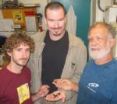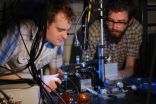(Press-News.org) Elevated levels of a growth protein in the brains of Alzheimer's disease (AD) patients is linked to impaired neurogenesis, the process by which new neurons are generated, say researchers at the University of California, San Diego in today's edition of The Journal of Neuroscience.
Eliezer Masliah, MD, professor of neurosciences and pathology in the UC San Diego School of Medicine and colleagues report that increased levels of BMP6 – part of a family of bone morphogenetic proteins involved in cell signaling and growth – were found in the brains of Alzheimer's patients and in mouse models of the disease.
BMP6 is primarily known to be involved in bone growth and the proliferation of non-neuronal glial cells in developing embryos. Its purpose in adult brains is less clear. "As a growth factor, it might initially be expressed for protective effect, a response to accumulating amyloid plaque proteins in Alzheimer's patients," said first author Leslie Crews, a post-doctoral researcher in Masliah's lab.
But too much BMP6 appears to be increasingly detrimental. Researchers found that levels of BMP6 grew in step with the progression of Alzheimer's disease. "In early stages of AD, there was less protein than there was in later, more advanced stages," said Crews.
Higher-than-normal levels of BMP6 were found in the dentate gyrus of Alzheimer's patients and around characteristic amyloid plaques in the hippocampus. Both regions of the brain are critical to memory formation and storage.
In cell cultures, the scientists found that BMP6 reduced the proliferation of cells, a discovery that suggests the protein could be a potential therapeutic target. "The next step is to see what happens when we normalize expression of BMP6," said Masliah. "If we can do that, it may possible to impact this part of AD's pathogenesis."
The protein provides an easier target than some molecules, said Crews, because it is secreted and circulates around cells in the brain. "We don't have to figure out how to get it into the brain and into cells," she said.
INFORMATION:
Co-authors of the study are Anthony Adame, Christina Patrick, Alexandra DeLaney, Emiley Pham and Edward Rockenstein of the Department of Neurosciences at UC San Diego and Lawrence Hansen of the Departments of Neurosciences and Pathology at UCSD.
Increased brain protein levels linked to Alzheimer's disease
2010-09-16
ELSE PRESS RELEASES FROM THIS DATE:
Arctic sea ice reaches lowest 2010 extent, third lowest in satellite record
2010-09-16
The Arctic sea ice cover appears to have reached its minimum extent for the year, the third-lowest recorded since satellites began measuring sea ice extent in 1979, according to the University of Colorado at Boulder's National Snow and Ice Data Center.
While this year's September minimum extent was greater than 2007 and 2008, the two record-setting and near-record-setting low years, it is still significantly below the long-term average and well outside the range of natural climate variability, according to CU-Boulder's NSIDC scientists. Most researchers believe the shrinking ...
Stress accelerates breast cancer progression in mice
2010-09-16
Chronic stress acts as a sort of fertilizer that feeds breast cancer progression, significantly accelerating the spread of disease in animal models, researchers at UCLA's Jonsson Comprehensive Cancer Center have found.
Researchers discovered that stress is biologically reprogramming the immune cells that are trying to fight the cancer, transforming them instead from soldiers protecting the body against disease into aiders and abettors. The study found a 30-fold increase in cancer spread throughout the bodies of stressed mice compared to those that were not stressed. ...
'Warrior worms' discovered in snails; UCSB scientists see possible biomedical applications
2010-09-16
(Santa Barbara, Calif.) –– Scientists at UC Santa Barbara have discovered a caste of genetically identical "warrior worms" –– members of a parasitic fluke species that invades the California horn snail. The findings are reported in the early online version of the Proceedings of the Royal Society B.
"We have discovered flatworms in colonies with vicious, killer morphs defending the colony," said Armand M. Kuris, professor of zoology, in the Department of Ecology, Evolution and Marine Biology. "These flukes have a strongly developed social organization, much like some insects, ...
Fish schools and krill swarms take on common shape
2010-09-16
When fish or tiny, shrimp-like krill get together, it appears they follow the same set of "rules." According to a new study published online on September 16th in Current Biology, a Cell Press publication, shoals of fish and swarms of krill hang out in groups that take on the same overall shape; it's not a simple sphere, a cylinder, or ovoid, but something more akin to an irregular crystal, the researchers say.
"The fact that several species of fish and krill that live in very different locations—from the tropics to polar oceans—form shoals that are the same shape suggests ...
Night lights affect songbirds' mating life
2010-09-16
In today's increasingly urbanized world, the lights in many places are always on, and according to a report published online on September 16 in of Current Biology, a Cell Press publication, that's having a real impact on the mating life of forest-breeding songbirds.
"In comparison to chemical and noise pollution, light pollution is more subtle, and its effects have perhaps not received the attention they deserve," said Bart Kempenaers of the Max Planck Institute for Ornithology in Germany. "Our findings show clearly that light pollution influences the timing of breeding ...
Brain matter linked to introspective thoughts
2010-09-16
VIDEO:
This is an informal conversation with Mr. Stephen Fleming . This video relates to an article that is appearing in the Sept. 17, 2010, issue of Science, published by AAAS....
Click here for more information.
A specific region of the brain appears to be larger in individuals who are good at turning their thoughts inward and reflecting upon their decisions, according to new research published in the journal Science. This act of introspection—or "thinking about your ...
Optical chip enables new approach to quantum computing
2010-09-16
An international research group led by scientists from the University of Bristol has developed a new approach to quantum computing that could soon be used to perform complex calculations that cannot be done by today's computers.
Scientists from Bristol's Centre for Quantum Photonics have developed a silicon chip that could be used to perform complex calculations and simulations using quantum particles in the near future. The researchers believe that their device represents a new route to a quantum computer – a powerful type of computer that uses quantum bits (qubits) ...
Moon's craters give new clues to early solar system bombardment
2010-09-16
PROVIDENCE, R.I. [Brown University] — Take a cursory look at the moon, and it can resemble a pockmarked golf ball. The dimples and divots on its surface are testament that our satellite has withstood a barrage of impacts from comets, asteroids and other space matter throughout much of its history. Because the geological record of that pummeling remains largely intact, scientists have leaned on the moon to reconstruct the chaotic early days of the inner solar system.
Now a team led by Brown University planetary geologists has produced the first uniform, comprehensive catalog ...
'Archeologists of the air' isolate pristine aerosol particles in the Amazon
2010-09-16
Cambridge, Mass. and Manaus, Brazil – September 16, 2010 – Environmental engineers who might better be called "archeologists of the air" have, for the first time, isolated aerosol particles in near pristine pre-industrial conditions.
Working in the remote Amazonian Basin north of Manaus, Brazil, the researchers measured particles emitted or formed within the rainforest ecosystem that are relatively free from the influence of anthropogenic, or human, activity.
The finding, published in the September 16 issue of Science, could provide crucial clues to understanding cloud ...
MIT researchers discover an unexpected twist in cancer metabolism
2010-09-16
CAMBRIDGE, Mass. -- In a paper appearing in the Sept. 16 online edition of Science, Matthew Vander Heiden assistant professor of biology and member of the David H. Koch Institute for Integrative Cancer Research at MIT and researchers at Harvard University report a previously unknown element of cancer cells' peculiar metabolism. They found that cells can trigger an alternative biochemical pathway that speeds up their metabolism and diverts the byproducts to construct new cells.
The finding could help scientists design drugs that block cancer-cell metabolism, essentially ...






